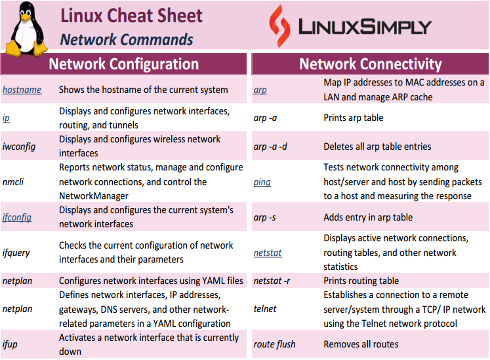Given Linux‘s popularity and adaptability, it is essential for developers and network administrators to understand and be knowledgeable about the various Linux network commands. I’ll give a brief overview of the most used Linux network commands in this article, along with a handy Linux network commands cheat sheet with information on their features and practical applications.
Download Linux Networking Commands Cheat Sheet
What Are Networking Commands in Linux?
On Linux systems, networking commands allow users to manage and monitor network connections and resources. These commands are useful for configuring network interfaces, troubleshooting network connectivity issues, and monitoring network traffic and performance.
Moreover, you can use these commands to view network configurations, configure network interfaces, check network status and connectivity, manage network services, and perform a variety of other networking-related tasks.
Linux Networking Commands Cheat Sheet
Linux networking commands cheat sheet will help you configure, troubleshoot, and monitor network connections. So, if you are a seasoned network administrator or just a beginner exploring Linux networking commands, this command list will be a valuable resource to have.
Network Configuration Commands for Linux Cheat Sheet
Here’s a cheat sheet for Linux network configuration commands that we can use to set up and manage a variety of network settings. Tasks related to network configuration include setting up network interfaces, allocating IP addresses, configuring DNS settings, setting up routing, and managing network security:
Here, you will find network connectivity commands for managing and monitoring network connections between devices. These commands will enable you to create and close connections and check the performance and status of already established connections: In this section, I have listed all DNS and name resolution commands you will need to manage and troubleshoot domain name resolution: This category includes network information commands that assist users in collecting information about remote systems, domains, and IP addresses: You can use network testing and monitoring commands to perform tasks such as measuring network bandwidth, monitoring network traffic, and troubleshooting network connectivity issues: You can use the network analysis and monitoring commands in this section to display network statistics, capture network packets, and identify performance issues with the network: The remote access commands allow you to connect securely to remote servers and manage them remotely from a local terminal. It is mainly essential for system administrators who manage multiple servers remotely and from a single location: The security commands will assist you in monitoring and controlling various security aspects of your system in order to improve system security: This section contains utility commands that will allow you to perform useful tasks such as transferring data, downloading files, and changing network interface settings: To conclude, I’ve provided a summary of the various Linux networking command categories, which are crucial tools for network administrators and users who need to manage and troubleshoot network connectivity and performance problems. I hope you find this article and the Linux network commands cheat sheet helpful. If you have any questions or suggestions, please comment below. To improve your understanding of Linux network administration, download the free PDF right away. To check network connectivity in the Linux command, you can use the The IP (Internet Protocol) command on Linux is one of the most useful and powerful tools for network interface configuration, routing table configuration, and many other networking-related tasks. To check the IP address in Linux, you can run To list networks in Linux, you can use the Command
Description
hostname
Shows the hostname of the current system
ip
Displays and configures network interfaces, routing, and tunnels
iwconfig
Displays and configures wireless network interfaces
netplan
Configures network interfaces using YAML files
ifconfig
Displays and configures the current system’s network interfaces
ifquery
Checks the current configuration of network interfaces and their parameters
nmcli
Reports network status, manage and configure network connections, and control the NetworkManager
netplan
Defines network interfaces, IP addresses, gateways, DNS servers, and other network-related parameters in a YAML configuration file
ifup
Activates a network interface that is currently down
ifdown
Deactivates a network interface that is currently up
dhclient
Automatically obtains an IP address and other network configuration information from a DHCP server
Network Connectivity Commands
Command
Description
arp
Map IP addresses to MAC addresses on a LAN and manage ARP cache
arp -a
Prints arp table
arp -a -d
Deletes all arp table entries
arp -s
Adds entry in arp table
netstat
Displays active network connections, routing tables, and other network statistics
netstat -r
Prints routing table
ping
Tests network connectivity among host/server and host by sending packets to a host and measuring the response time
route
Configures the kernel’s routing table
route flush
Removes all routes
traceroute
Displays the route packets take to reach a remote server through multiple hops
telnet
Establishes a connection to a remote server/system through a TCP/ IP network using the Telnet network protocol
w
Displays information about currently logged-in users
mail
Sends and receives email using the command line.
ngrep
Displays and filters network packet data on a given regex pattern
iw
Displays and configures wireless network interfaces
DNS and Name Resolution Commands
Command
Description
nslookup
Performs DNS lookups to resolve hostnames, IP addresses mapping or any specific DNS record
host
Performs DNS lookups to resolve hostnames or IP addresses.
dig
Performs DNS lookups to query information about DNS name servers
Network Information Commands for Linux Cheat Sheet
Command
Description
finger
Shows user login information on a remote system
jwhois
Fetches information about domain ownership from various WHOIS servers
Network Testing and Monitoring Commands
Command
Description
hping
Assambles and analyses TCP/IP packets and sends packets to a remote host and analyzes the responses
mtr
Works as a combination of traceroute and ping commands, sends packets with the ping time for each hop continuously
nc / netcat /ncat
Provides the ability to read and write data across network connections
smokeping
Measures network latency and packet loss between two hosts, runs checks in certain intervals
socat
Transfers data between two bidirectional byte streams
speedometer
Displays bandwidth usage in real-time
speedtest-cli
Measures network performance by performing a speed test
ss
Displays active network connections, socket statistics, and other network-related information
tracepath
Traces the route packets take discovering MTU along this path
Network Analysis and Monitoring Commands
Command
Description
tcpdump
Captures and analyzes network traffic in real-time
nmap
Scans a network to discover hosts and services or for security
bmon
Displays bandwidth usage in real-time for individual network interfaces
bwm-ng
Monitors current bandwidth for multiple network interfaces
iftop
Displays real-time network bandwidth usage by individual connections
iperf
Tests network performance within two systems
iptraf-ng
Monitors and displays network traffic in real-time
nethogs
Monitors network traffic by process and displays bandwidth usage.
vnstat
Keeps track of hourly, daily and monthly network traffic for selected interfaces and displays statistics on a console
Remote Access Commands for Linux Cheat Sheet
Command
Description
ssh
Securely connects to a remote system using the SSH protocol
scp
Copies files securely between client and server using the SSH protocol
sftp
Securely transfers files between hosts using the SFTP protocol
Security Commands
Command
Description
iptables
Firewall utility that manages packet filtering and NAT.
snort
Intrusion detection system that analyzes network traffic for suspicious activity
wireshark
Captures and analyzes network traffic in a formatted text
ufw
Manages system firewall and adds/deletes/modifies/resets packet filtering rule
Utility Commands for Linux Cheat Sheet
Command
Description
curl
Transfers data from or to a server
aria2
Supports various protocols for downloading files from the internet
ethtool
Modifies network interface settings, such as speed and queries information of those devices
wget
Command-line utility for downloading files from the web
Conclusion
People Also Ask
How to check network connectivity in Linux command?
“ping” command followed by a hostname or IP address of your choice in the terminal. The syntax is "ping <hostname or IP address>".What is the IP command?
How to check IP address in Linux?
“ifconfig” command in your terminal that displays all the information about the IP. Besides, you can use “ip addr” or “ip a” to check the IP address in Linux.What is the command to list networks in Linux?
“netstat” command in your terminal. You can run “netstat -a” to check all the active internet connections.
FUNDAMENTALS
A Complete Guide for Beginners

